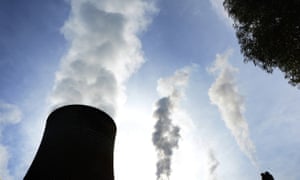Government spends less than $1m for cut equivalent to only 0.01% of Australia’s annual greenhouse gas pollution
The Morrison government’s main climate change policy, the emissions
reduction fund, has been labelled “a joke” after its latest auction
bought cuts equivalent to only 0.01% of Australia’s annual greenhouse
gas pollution.
While the prime minister, Scott Morrison, announced prior to the election that the policy would get an additional $2bn funding, the first post-election auction from the fund dedicated less than $1m to just three emissions reduction projects.
Combined, the three projects are promised to cut emissions by 59,000 tonnes over a decade – just 0.06% of the 100m-tonne cut Morrison said the rebadged “climate solutions” fund would deliver as part of a government plan to meet the target set at the Paris climate summit.
It will reinforce the expert view that Australia will not meet its Paris commitment under current policy settings. Australia’s emissions have risen each year since the Coalition replaced a carbon price scheme with the emissions reduction fund.
The result is the worst of nine auctions using the fund, under which
landowners and businesses bid for taxpayers’ support for projects to
reduce emissions at lowest cost.While the prime minister, Scott Morrison, announced prior to the election that the policy would get an additional $2bn funding, the first post-election auction from the fund dedicated less than $1m to just three emissions reduction projects.
Combined, the three projects are promised to cut emissions by 59,000 tonnes over a decade – just 0.06% of the 100m-tonne cut Morrison said the rebadged “climate solutions” fund would deliver as part of a government plan to meet the target set at the Paris climate summit.
It will reinforce the expert view that Australia will not meet its Paris commitment under current policy settings. Australia’s emissions have risen each year since the Coalition replaced a carbon price scheme with the emissions reduction fund.
The Clean Energy Regulator, the government agency that runs the fund, said the auction marked an important milestone “as the carbon market gears up”. The three contracts it signed will cost $840,000, at an average of $14.17 a tonne of carbon dioxide reduction.
Richie Merzian, from progressive thinktank the Australia Institute, said the result “looked like a joke”. “This is the central mechanism for reducing Australia’s emissions and it purchases a minuscule amount. What’s the point of topping it up with $2bn?” he said.
“The only thing the climate solutions fund solved was the government’s re-election. It sure won’t solve Australia’s rising emissions with this miserly effort.”
The energy reductions minister, Angus Taylor, said across nine auctions the government had signed contracts for 780 projects that would deliver 192m tonnes in cuts over a decade. He suggested the result of the latest auction, held on 24 and 25 July, was affected by Labor promising to abolish the fund if it won power at the election.
Labor’s climate spokesman, Mark Butler, said the fund “was never anything but a fig leaf”. “This shows Scott Morrison and the Liberals have a disastrous climate change policy,” he said.
The Carbon Market Institute, representing businesses holding contracts for 70% of the emissions cuts contracted under the fund, said the auction result highlighted the need to reboot Australia’s climate policies.
The institute’s chief executive, John Connor, said it was a “surprisingly small” result even after factoring in uncertainties about the fund’s operation and an expectation that Labor would win the election and change national climate policy.
He said the government was trying to improve and expand the fund but it should create a better carbon market by strengthening the “safeguard mechanism”, which was promised to limit emissions from big industry but under which companies have largely been allowed to nominate their own pollution level, leading to increases.
In a statement, the Clean Energy Regulator said it had rejected several bids of more than $15 a tonne of emissions reduction as they were not considered “value for money in the current environment”.
Bret Harper, the director of research at analyst firm RepuTex, said the regulator had faced a choice: to either pay more per tonne of carbon dioxide and make deeper cuts, or to maintain the current price. He said it should have paid more.
“The price point is wrong,” Harper said. “At this rate they are in danger of having more abatement cancelled [through contracts from earlier auction rounds not being fulfilled] than they are contracting.”
Taxpayers have so far paid out $564m and committed another $1.74bn, with $237m of historic funding yet to be spent. In February, Morrison promised an additional $2bn funding over 10 years, but that was stretched to 15 years in the pre-election budget. Just $149m has been allocated over the next four years.
A Guardian investigation last year found while projects supported by the fund have merit, particularly those that restore native vegetation, it is difficult to know what taxpayers are getting for their money. Some methodologies paid for cuts that would have happened anyway. Others have had any cuts more than wiped out by increases in pollution allowed elsewhere.
The government says it will cut emissions by 26-28% below 2005 levels by 2030. The independent Climate Change Authority recommended Australia should make a cut of 45% to 63% over this period.
David Parker, the regulator’s chairman, said the agency looked “forward to working closely with participants and industry to explore new and innovative ways to implement the climate solutions fund”.

No comments:
Post a Comment